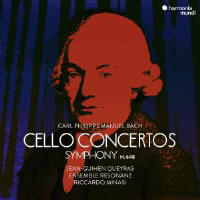Texte paru dans: / Appeared in: |
|
|
Outil de traduction ~ (Très approximatif) |
|
|
Reviewer: Michael
De Sapio
French cellist Jean-Guihen
Queyras has received a number of positive reviews here in Fanfare, and this
release is no exception to the trend. The two C. P. E. Bach concertos are
plum assignments for cellists, offering opportunities for urgent drama and
emotionally charged lyricism, and substantial interplay with the orchestra
too. Queyras plays with silky suavity, maintaining a cool but never
disengaged tone that acts as a foil to the passion of Ensemble Resonanz. The
latter brings fire and biting attack to the nervy outer movements of the
A-Minor Concerto. The exchanges between cello and orchestra in the slow
movements of the concertos are most poignant. Also worthy of mention is the
audible and very fine harpsichord continuo. The symphony included here as a palate cleanser is an early and brief one from 1741, scored for strings only. The opening movement is rumbustious and noisy, but the strings use broad, singing phrasing to contrast with the acrobatic figuration elsewhere. If I’m not mistaken, Riccardo Minasi has added mandolins to the slow movement—a very empfindsamer number—lending it a decidedly Italianate quality. Ensemble Resonanz gets the most out of the dynamic and character contrasts in this music. An excellent question is posed on the back blurb: “Why should music ‘before Mozart’ now be the sole preserve of period-instrument orchestras?” On the evidence of this recording, Ensemble Resonanz is one of the many chamber orchestras that are showing how period know-how can be adapted to modern hardware. It helps that the musicians—including their leader, noted Baroque violinist Minasi—are familiar with the subtleties of gut-string performance and bring this expertise to bear on their metal-strung modern instruments. But what really makes this disc is the sensitive, poetic, and never ostentatious cello playing of Jean-Guihen Queyras. Altogether, an invigorating C. P. E. Bach outing. | |
|
|
|
|
Cliquez l'un ou l'autre
bouton pour découvrir bien d'autres critiques de CD |
|




